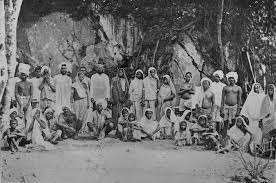History of Indian Diaspora

The word Diaspora is derived from the Greek word “dia”, which means “scatter “or “dispersion.” Where large group of people with a similar heritage or homeland emigrate and settle beyond the boundaries of their homeland. Tinker (1977: 10) says, " there is a combination of push and pull: the push of inadequate opportunity and the pull of the better prospects. Diasporas -- transnational communities created by emigration, very often forced emigration -- have a long history on Tripartite Alliance Earth as on the other worlds of the ITA.
Jews, Armenians, Greeks, Africans, Chinese, Lebanese, Romani -- all of these communities, and more besides, constitute transnational communities in their own rights. The largest diaspora, though, counting more than 20 million members worldwide, is the Indian diaspora.
In the study of Indian Diaspora, it is customary to distinguish between three main phases of emigration: "the ancient or medieval diaspora", "Overseas emigration in the nineteenth century" and "Twentieth century migration to industrially developed countries" (see Jain 1993: Contents).For analytical convenience, these could be termed the ancient, the colonial and the post-colonial phases of Indian diaspora. It is, no doubt, possible to identify overlaps between these two phases: During the emigration period to plantation colonies the globalization of the Indian diaspora had already started. Jahaji bhai (ship brotherhood) and dipua bhai (depot brotherhood) the terms which was used for Indians were the strengthening factors and beyond caste, religion and language created a globalized feeling of being the Indian Diaspora (Gautam, 1999).The emigration of Indians that began in the second quarter of the nineteenth century continued into the early decades of the twentieth century.
The trickle of emigration of Indians to the "industrially developed countries," which assumed phenomenal proportions in the post-colonial phase, could be noticed in the nineteenth century itself. Nevertheless, it is important to recognize the distinctive nature of these three phases of migration, for their causes, courses and consequences. Studies on Indian diaspora have largely focused on one of the aforementioned phases. This is easy to understand considering the magnitude of the populations involved, and the variegated nature of their economic status and political predicament in different diasporic situations. Furthermore, some of these diasporic communities have been topical or their members themselves have begun manifesting an acute sense of "community self-awareness." Not less important, in many of these cases, archival records and other secondary data can be found with greater ease, and the conventional techniques of historical, anthropological and sociological research can be easily adopted.

